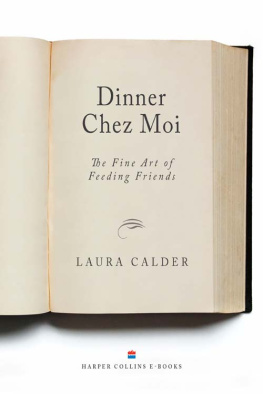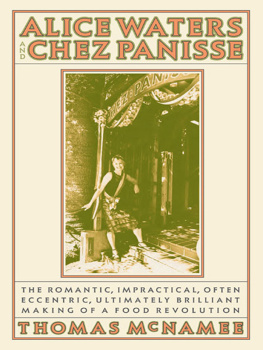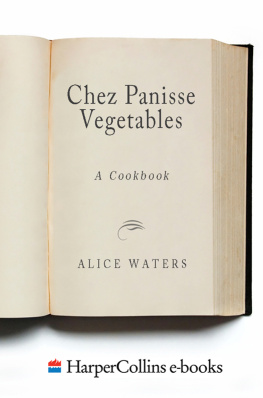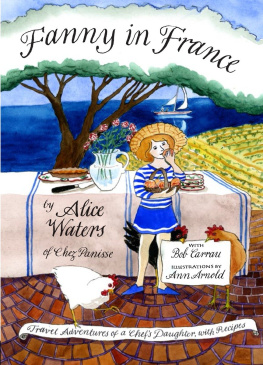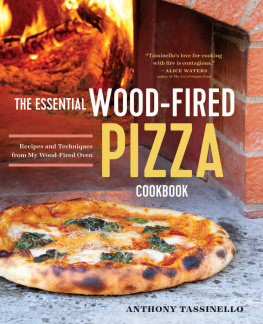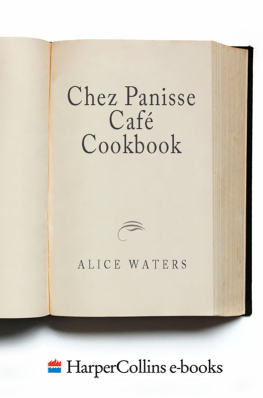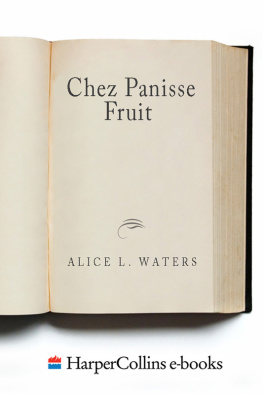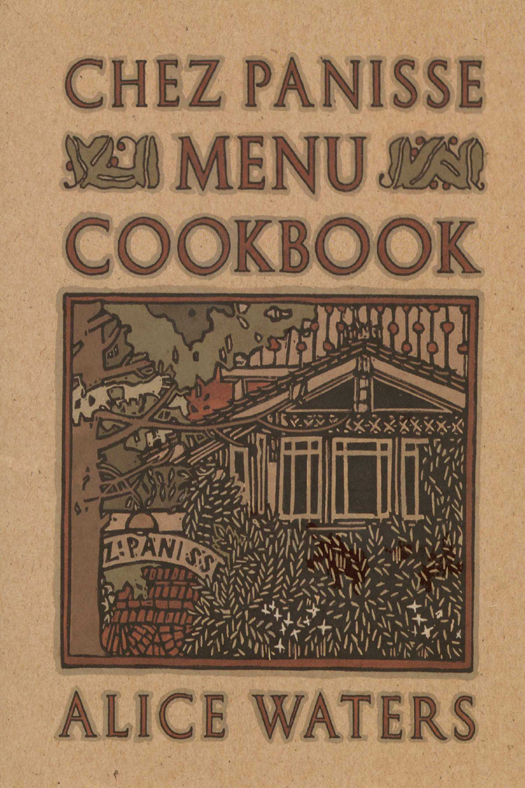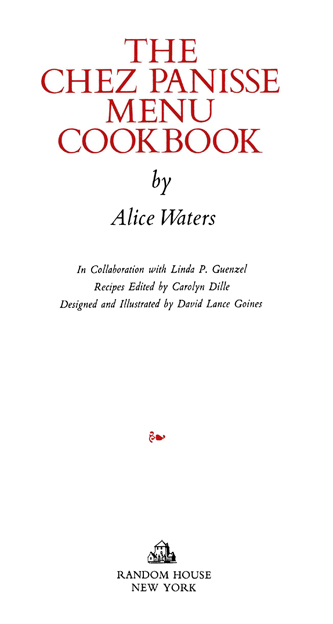The Chez Panisse Cookbook Library
Chez Panisse Cooking
Chez Panisse Desserts
Chez Panisse Menu Cookbook
Chez Panisse Pasta, Pizza, & Calzone
The truth of the matter is that the restaurant and this book exist only because our customers have constantly expanded our horizons along with their own.
G.B.
Copyright 1982 by Alice L. Waters
All rights reserved under International and Pan-American Copyright Conventions.
Published in the United States by Random House, Inc., New York, and simultaneously in Canada by Random House of Canada Limited, Toronto.
This work was originally published in hardcover by Random House, Inc., in 1982.
Library of Congress Cataloging-in-Publication Data
Waters, Alice.
The Chez Panisse menu cookbook.
Includes index.
1. Cookery, French. 2. Chez Panisse.
I. Title.
TX719.W34 641.5944 8140215
eISBN: 978-0-345-52989-3
v3.1
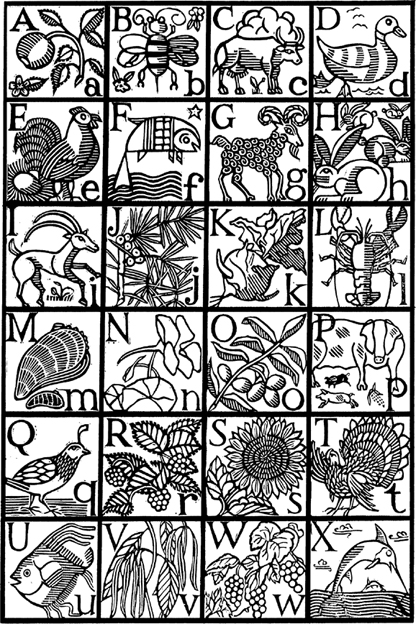
BIRTHDAY DINNER FOR LINDA NOVEMBER 8, 1980 FRUITS DE MER SUR LE GRIL LES PETITES SALADES CHEZ PANISSE CHOU ET CANARD SAUVAGE HARICOTS VERTS ET CHANTERELLES CRESSON ET ENDIVE COTE DE BOEUF A LANCHOIADE POMMES ALLUMETTES FROMAGE DE CHAUME ET FRUITS MONT BLANC
ACKNOWLEDGMENTS
This book would never have been written but for Linda Guenzels belief in me and in Chez Panisse. She transcribed my ramblings, organized my thoughts, and overcame my doubts, all with tireless enthusiasm. I cannot thank her enough for the countless hours she has given me so generously. This book is as much hers as mine.
My sincere thanks to Carolyn Dille for extracting and codifying these recipes; to Jean-Pierre Moull for continuing to cook dinners at the restaurant while helping me taste, evaluate, and refine the recipes; to Pat Curtan for her friendship, inspiration, and collaboration; to Fritz Streiff for his valuable finishing touches; and to David Goines for wanting to realize this cookbook design.
My gratitude to my partners, Tom Guernsey, Jerry Budrick, and pastry chef Lindsey Shere for keeping everything going at the restaurant; and to my former partner, Jeremiah Tower, my gratitude for his innovative and inspiring cooking at Chez Panisse. And I want to especially thank Gene Opton for her generosity and trust during the first precarious years of Chez Panisse.
Special thanks to Todd Koons, Steve Sullivan, Sharon Monday, Eleanor Bertino, Tom Luddy, Jean-Pierre Gorin, Nathalie Waag, Marion Cunningham, Joyce Goldstein, Barbara Carlitz, Frances Garbellano, Doris Muscatine, Victoria Wise, Craig Sutter, Greil Marcus, David Stewart, Fred Guenzel, Judy Newman, and my parents.
For their inspiration and encouragement I want to thank Gerald Asher; my friends at the Cheeseboard; Martine Labro; Kermit Lynch; Madeleine Kamman; Richard Olney; Diana Kennedy; James Beard; my friends at Tassajara, Greens, and Green Gulch; Darrell Corti; Lulu and Lucien Peyraud; Elizabeth David; Susan and Bob Lescher; Bob Finigan; Mark Miller; Dianne Johnson; M.F.K. Fisher; Judith and Evan Jones; and my editor, Jason Epstein.
INTRODUCTION
Food must be experienced, and I worry that writing about it may not make the sense I want it to! I wish I could just sit people down and give them something to eat; then I know they would understand. Since I cannot do that, I hope that an explanation of how I became involved with food and why I started Chez Panisse will allow a vicarious understanding.
I believe that many of my aesthetic principles have their roots in my early childhood. A picky eater, my father would say, and I wouldnt eat just any old thing. I wanted green beans and rare charcoal-grilled steaks every birthday dinner. I remember sitting out in the strawberry patch, happily devouring those fresh berries. I can still taste the applesauce made from the fruit of my apple tree, and can smell the apple blossoms. Friends of the family had a cottage up at the lake, and I was delighted by the possibilities of a seven-foot barbecue in the sand. We had clambakes, complete with roasted corn, chicken, and blueberries we had picked out on the islands. I still love corn, but that was the best. Though I never had anything unusual to eat when I was little, I was lucky to have tasted fresh fruits and vegetables from the garden.
At the age of nineteen I went eating in Francethe best description of my year of study abroad. I began eating all kinds of wonderful things Id never tasted before. It was the first time for so many foodsoysters, crayfish, musselsand I liked everything. The idea of ever opening a restaurant hadnt entered my conscious mind, but I experienced a major realization: I hadnt eaten anything, comparatively speaking, and I wanted to taste everything. I began to see a patterna technique for looking at food, examining it, and understanding it.
In France, for the first time, I found that people would spend an hour or more deciding where to eat. My French friends would drive around on Sunday afternoon, stopping at all the restaurants in town to see who had the best of whatever was fresh and in season, and then they would agonize over the final choice, a process of selection that showed much respect for food.
A little stone house we just happened upon in Brittany was the setting for one of the most memorable meals of my life. I had eaten all over France, and it was here that I first heard usually reserved Frenchmen exclaim over the food. Elsewhere, even when I found the food to be wonderful, they would say only that it was all right; but after the meal in this tiny restaurant, they applauded the chef and cried, Cest fantastique! Ive remembered this dinner a thousand times: the old stone house, the stairs leading up to the small dining room, which seated no more than twelve at the pink cloth-covered tables and from which one could look through the opened windows to the stream running beside the house and the garden in back. The chef, a woman, announced the menu: cured ham and melon, trout with almonds, and raspberry tart. The trout had just come from the stream and the raspberries from the garden. It was this immediacy that made those dishes so special.
I now knew that I loved to eat and that I wanted to eat certain foods of a certain quality. I bought Elizabeth Davids book, French Country Cooking, and I cooked everything in it, from beginning to end. I admired her aesthetics of food, and wanted a restaurant that had the same feeling as the pictures on the covers of her books. It was so important that I was driven, as if I had a sense of mission. I didnt envision success. All I cared about was a place to sit down with my friends and enjoy good food while discussing the politics of the day. And I believed that in order to experience food as good as I had had in France, I had to cook and serve it myself.
The timing and the location encouraged my idealism and experimentation. This was during the late sixties, in Berkeley. We all believed in community and personal commitment and quality. Chez Panisse was born out of these ideals. Profit was always secondary.
Chez Panisse began with our doing the very best we could do with French recipes and California ingredients, and has evolved into what I like to think of as a celebration of the very finest of our regional food products. The recipes of Elizabeth David and Richard Olney provided a starting point and an inspiration to us; and we soon realized that the similarity of Californias climate to that of the south of France gives us similar products that require different interpretations and executions. My one unbreakable rule has always been to use only the freshest and finest ingredients available. Our quest for the freshest and best of the region has led us to Amador County for suckling pigs and wonderful, peppery watercress; to the Napa Valley for Zinfandel made especially for the restaurant; to Gilroy for garlic; to Sonoma County for locally made goat cheeses; to the ocean daily for oysters; to the backyards of our customers where we have our own gardens; and finally, if we must, to the local produce markets for that which we cannot grow or procure ourselves. Our goal is to be totally self-sufficient so that we need not depend upon the unreliable quality and inconsistencies of the commercial food wholesalers.


